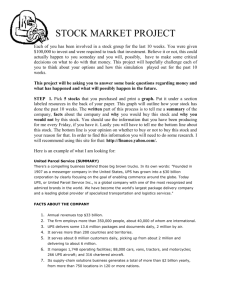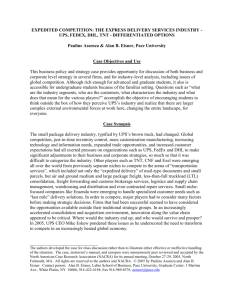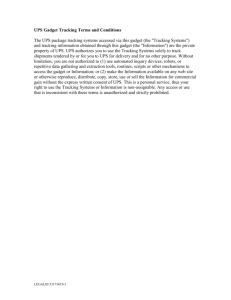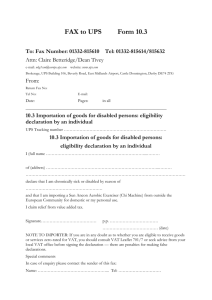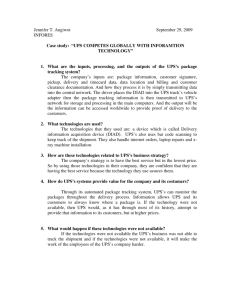Stock Market Project Packet
advertisement
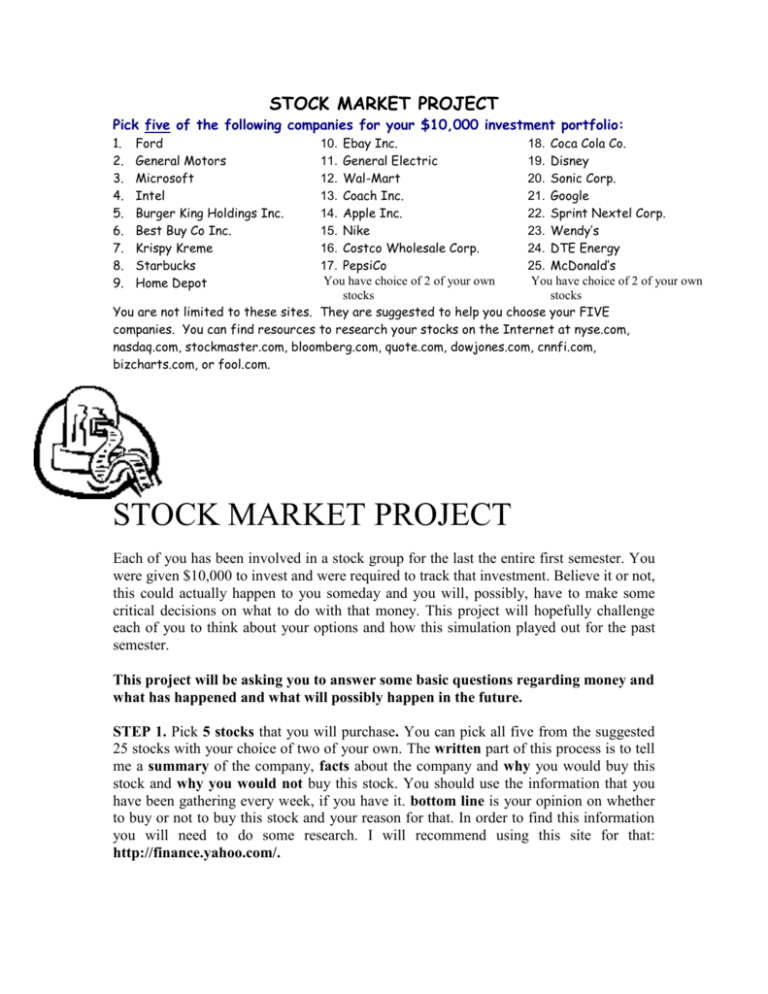
STOCK MARKET PROJECT Pick five of the following companies for your $10,000 investment portfolio: 1. 2. 3. 4. 5. 6. 7. 8. 9. Ford General Motors Microsoft Intel Burger King Holdings Inc. Best Buy Co Inc. Krispy Kreme Starbucks Home Depot 10. Ebay Inc. 18. Coca Cola Co. 11. General Electric 19. Disney 12. Wal-Mart 20. Sonic Corp. 13. Coach Inc. 21. Google 14. Apple Inc. 22. Sprint Nextel Corp. 15. Nike 23. Wendy’s 16. Costco Wholesale Corp. 24. DTE Energy 17. PepsiCo 25. McDonald’s You have choice of 2 of your own You have choice of 2 of your own stocks stocks You are not limited to these sites. They are suggested to help you choose your FIVE companies. You can find resources to research your stocks on the Internet at nyse.com, nasdaq.com, stockmaster.com, bloomberg.com, quote.com, dowjones.com, cnnfi.com, bizcharts.com, or fool.com. STOCK MARKET PROJECT Each of you has been involved in a stock group for the last the entire first semester. You were given $10,000 to invest and were required to track that investment. Believe it or not, this could actually happen to you someday and you will, possibly, have to make some critical decisions on what to do with that money. This project will hopefully challenge each of you to think about your options and how this simulation played out for the past semester. This project will be asking you to answer some basic questions regarding money and what has happened and what will possibly happen in the future. STEP 1. Pick 5 stocks that you will purchase. You can pick all five from the suggested 25 stocks with your choice of two of your own. The written part of this process is to tell me a summary of the company, facts about the company and why you would buy this stock and why you would not buy this stock. You should use the information that you have been gathering every week, if you have it. bottom line is your opinion on whether to buy or not to buy this stock and your reason for that. In order to find this information you will need to do some research. I will recommend using this site for that: http://finance.yahoo.com/. Here is an example of what I am looking for: United Parcel Service (SUMMARY) There's a compelling business behind those big brown trucks. In its own words: "Founded in 1907 as a messenger company in the United States, UPS has grown into a $30 billion corporation by clearly focusing on the goal of enabling commerce around the globe. Today UPS, or United Parcel Service Inc., is a global company with one of the most recognized and admired brands in the world. We have become the world's largest package delivery company and a leading global provider of specialized transportation and logistics services." FACTS ABOUT THE COMPANY 1. Annual revenues top $33 billion. 2. The firm employs more than 350,000 people, about 40,000 of whom are international. 3. UPS delivers some 13.6 million packages and documents daily, 2 million by air. 4. It serves more than 200 countries and territories. 5. It serves about 8 million customers daily, picking up from about 2 million and delivering to about 6 million. 6. It manages 1,748 operating facilities; 88,000 cars, vans, tractors, and motorcycles; 266 UPS aircraft; and 316 chartered aircraft. 7. Its supply-chain solutions business generates a total of more than $2 billion yearly, from more than 750 locations in 120 or more nations. Why UPS Here are some reasons to consider UPS for your portfolio: It has solid profit margins. Whereas FedEx sports a net profit margin in the neighborhood of 3%, UPS's margins approach 11% and they've been growing. That's a big difference, revealing that UPS is able to operate its business less expensively, and thereby keep more of each dollar of revenue. To some degree, this difference is tied to UPS's lesser reliance on aircraft for many deliveries. It's got a protective moat around its ground delivery business. FedEx is encroaching on this territory, as is the U.S. Postal Service, but ultimately, matching or beating it will be hard to do. Meanwhile, UPS is encroaching on FedEx's higher-margin express delivery services. It has strong and growing cash flow. UPS generates a lot of cash and has been steadily generating more and more of it. In recent years, it has been coughing up more than twice the cash flow of FedEx. Why (not) UPS The strongest argument against investing in UPS is simply its price. The company's not exactly very undervalued right now. Its price-to-earnings (P/E) ratio of around 28 is somewhat higher than its historic range in the mid-20s. (Historic since the firm went public in 1999, that is.) The bottom line Interestingly, both UPS and FedEx have been making significant inroads into each other's prime territory. The question of who will win is intriguing, but the ultimate result may well be that both win. After all, the world seems capable of sustaining both Coca-Cola (NYSE: KO) and PepsiCo (NYSE: PEP), and both McDonald's (NYSE: MCD) and Wendy's (NYSE WEN). STEP 2: Answer the following questions regarding your portfolio. 1. What was your biggest gainer? 2. What was your biggest loser? 3. Did you make money overall or did you lose money? 4. Which stock in your portfolio had very little change? 5. What was your most volatile stock? 6. What was the determining factor when you purchased stock? What made you buy a certain stock? STEP 3: TWO PARTS1.) This section will also require research like the first section of the project. For the research portion of this section look up two (2) options for investing $10,000 not including the stock market. Lastly, list the 3 advantages and 3 disadvantages of this type of investment, explaining each from your research. This will be written out in a paragraph for each of the options. 2.) Interview 3 different people from 3 different age groups (30 and older only). Ask them if they have ever invested in the stock market? What would they invest in if they had $10,000 dollars? Any advice they could give to a young person about investing. You will need the signature of the person on a piece of paper and in that persons writing write down what they would do with the money. Make sure to thank them after they have answered the questions. STEP 4: This section will require you to use all of your data collected on each stock. You must make a line graph for each stock. Each line graph must have the purchase price and the price of your stock for every week. Please use the closing price for your data. This section will illustrate how successful, volatile, or poor your stock has performed in the 15 week project time. Dates: 9-05 9-12 9-19 9-26 10-3 10-10 10-17 10-24 10-31 11-7 11-14 11-21 11-28 12-5 Rubric: Cover page: 10 points Use a blank sheet of paper stapled to the front of your project with your name in the lower left hand corner, my name, and the period. Table of contents: Introduction Step 1: Step 2: Step 3: Step 4: Bibliography (make sure to have correct format MLA): Conclusion 20 points 20 points This will be one paragraph describing to me what you will be discussing in this project. 50 points 50 points 50 points 50 points 10 points http://www.norfacad.pvt.k12.va.us/speech/Biblio.htm 20 points This will be one paragraph describing to me your concluding thoughts and wrapping things up. Neatness/ spelling and organization: TOTAL 20 points 300 points DUE DATE: This project is a TERM ASSIGNMNET and will not be accepted late under any circumstances. It is DUE 12/17/2014. Other: Good luck and it would be to your benefit to start this project NOW!

